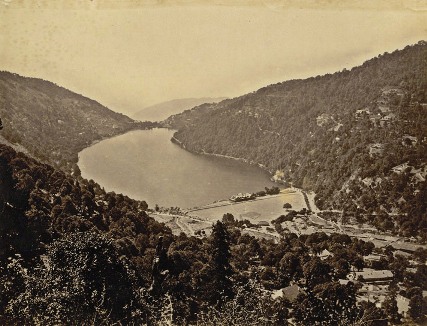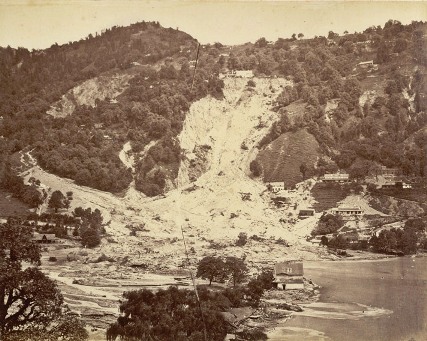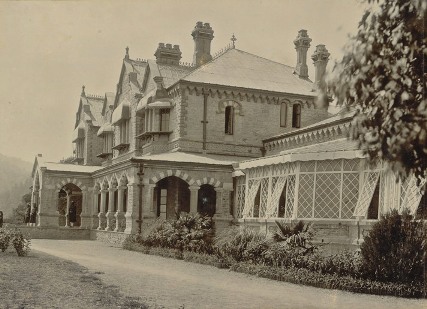
Photograph of Nainital from the Macnabb Collection – 1885
History of Nainital
It is believed that Nainital history figures in some ancient myths of India. In the Manas Khand of the Skand Puranas, Nainital Lake is called Tri-Rishi-Sarovar, hinting at the story of three sages (or rishis), Atri, Pulastya and Pulaha, who, upon finding no water in Nainital, dug a large hole at the location of the present day lake (sarovar = lake) and filled it with water from the holy lake Manasarovar in Tibet. According to lore, a dip in Naini Lake, “the lesser Manasarovar,” earns merit equal to a dip in the great lake.
It is also believed that The Naini Lake is one of the 64 Shakti Peeths, or religious sites where parts of the charred body of Sati (Parvati) fell on earth while being carried by Lord Shiva. The spot where Sati’s eyes (or Nain) fell, came to be called Nain-tal or lake of the eye. The goddess Shakti is worshipped at the Naina Devi Temple on the north shore of the present day lake.
The Kumaon Hills came under British rule after the Anglo-Nepalese War (1814–16), but the hill station town of Naini Tal was founded only in 1841 , with the construction of the first European house (Pilgrim Lodge) by P. Barron, a sugar trader from Shahjahanpur. In his memoir, he wrote: “It is by far the best site I have witnessed in the course of a 1,500 miles (2,400 km) trek in the Himalayas.”
In 1846, when a Captain Madden of the Bengal Artillery visited Naini Tal, he recorded that “houses were rapidly springing up in most parts of the settlement: some towards the crest of the limitary ranges were nearly 7,500 ft (2,300 m) above sea level: the rugged and woody Anyarpatta (Anyar-patt – in Kumaoni means – complete blackout.
The reason for this nomenclature by the localities was because there were minimal sun rays due to its location and dense forests) was being gradually planted and that the favorite sites were on the undulating tract of forest land which stretched back from the head of the lake to the base of China and Deopatta (Camel’s Hump).
The Church, St. John in the Wilderness, had been built Soon the town became a health resort favored both by British soldiers and by colonial officials and their families trying to escape the heat of the plains. Later, the town also became the summer residence of the Governor of the United Provinces . The present king of Kumaon is Raja Mahendra Chand of Lamakhet (Pithoragarh), he is married to Rani Gita Chand of Rina and has three childrens (Rajkumari Aakanksha Chand, Rajkumari Mallika Chand, Rajkumar Aryan Chand).

Photograph of the aftermath of the Nainital landslip from the Macnabb Collection – 1880.
In September 1880 a landslide (the Landslip of 1880) occurred at the north end of the town, burying 151 people.The first known landslide had occurred in 1866, and in 1879 there was a larger one at the same spot, Alma Hill, but “the great slip occurred in the following year, on Saturday 18 September 1880.Two days preceding the slip there was heavy rain, … 20 inches (510 mm) to 35 in (890 mm) fell during the 40 hours ending on Saturday morning, and the downpour still lasted and continued for hours after the slip.
This heavy fall naturally brought down streams of water from the hill side, some endangering the Victoria Hotel, (which) was not the only building threatened … Bell’s shop, the Volunteer Orderly Room and the Hindu (Naina Devi) temple were scenes of labour with a view to diverting streams. At a quarter to two the landslip occurred burying those in and around the buildings mentioned above.” The total number of dead and missing were 108 Indian and 43 British nationals.
The Assembly Rooms and the Naina Devi Temple were both destroyed in the disaster. A recreation area known as ‘The Flats‘ was later built on the site and a new temple was also erected. To prevent further disasters, storm water drains were constructed and building bylaws were made stricter.
In the latter half of the 19th century a number of “European” schools for boys and girls were founded in Nainital. During the Victorian and Edwardian eras, students in these schools consisted largely of children of British colonial officials or soldiers. In 1906, for example, there were over half a dozen such schools, including the Diocesan Boys’ School (later renamed Sherwood College). Another famous school formed in 1888 was the St. Joseph’s College, Nainital which is still a famous day-boarding and residential school built by Irish brothers. St.Joseph’s College will be celebrating its 125th anniversary in the year of 2013. St. Joseph’s College is popularly known as SEM.

View of the Old Government House
By the 1880s, a mere 42 years after its founding, Nainital had become something of an exclusive English preserve, with the Indian presence in the town confined largely to a behind-the-scenes labour and service industry, or to the occasional prince. This state of affairs lasted for much of the Victorian era. The first signs of change came early in the 20th century, when Indian bureaucrats and professionals began arriving in town as part of the annual migration of the state government of the United Provinces to Nainital every summer. By 1901 its population had risen to 7,609.
The next big change came in 1925, when British civil servants began to receive subsidies for taking their annual vacations in England and, consequently, many stopped going to the hill stations in the summers. From then on until 1947 (excepting the war years), the British presence in Nainital (measured, for example, by home ownership) continued to decline and was gradually replaced by a burgeoning Indian presence.
